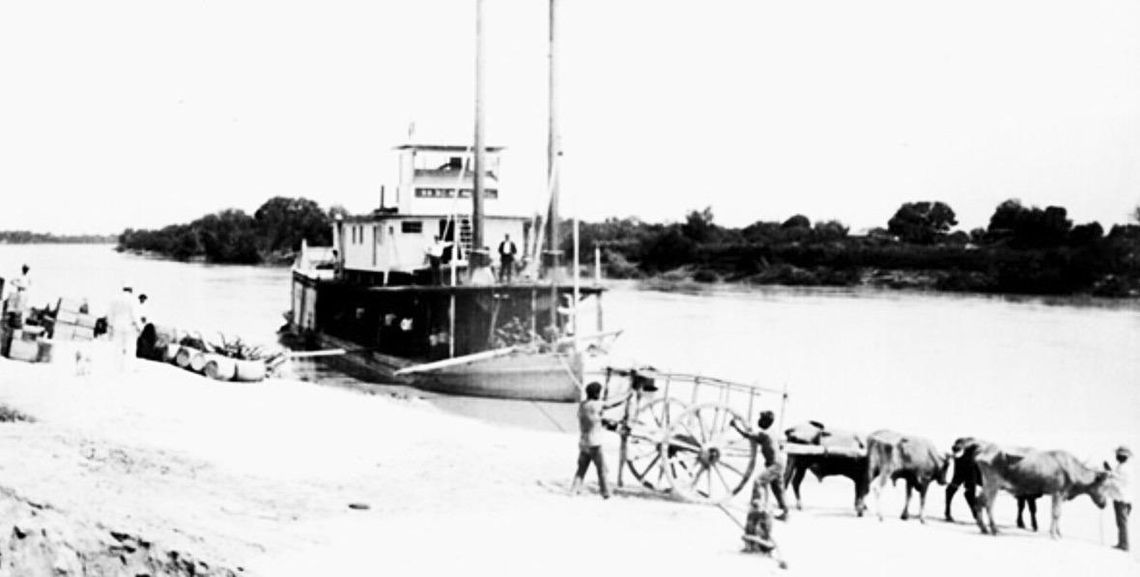Steamboat Launched. The new steamboat built for Messrs Ward & Co. of Matagorda and intended for the navigation of the Colorado above the raft, was launched on the 21st ULT. She has been christened the Kate Ward. She is 110 feet keel, 24 feet beam, and is calculated to carry 600 bales of cotton in three feet of water; her present draft is only 5 inches.
In June of this same year, 1844, the La Grange Intelligencer announced that local businessman Samuel Ward planned to build a steamboat that would ply the Colorado. Of course, even back then, few things would happen as expected, and the vessel did not actually slip down the ways into the river until Saturday, June 21, of the following year. Ward named the boat after his sister, Kate and when loaded with 600 bales of cotton, she would draw much less water than her original draft of 5 inches.
On March 8, 1846, the boat made it from La Grange to Austin. Practically, the whole town turned out to see the steamboat tied up at the foot of Congress Avenue. Three days later, the boat went even farther upstream, carrying a delegation of business leaders, lawmakers, and U.S.
Army officers several miles up stream to a point called Mormon Falls near the present-day Mt. Bonnel in Austin.
Soon, reality set in. Austin could only be reached by a big boat when the river ran, which generally happened in the spring and sometimes during the autumn rains. But for the next few years, The Kate Ward operated between La Grange, with her mooring point near Colorado Landing, and the Colorado River Raft, a driftwood logjam about twenty miles above the mouth of the river. From that point freight went by wagon to Matagorda and steamships operating in the Gulf.
A flood would cut out a chan nel through the raft in 1848, The Kate Ward made it out on the river and into the open Gulf for the first time. From then until 1850, she operated on the Guadalupe River, Victoria and Pass Cavallo, one of five outlets on Matagorda Bay, making the trip in two days.
By 1852, The Kate Ward was back on the Colorado, being used as a snag boat to keep the lower part of the river navigable. In the summer of 1853, the federal government bought the boat and had her overhauled. By the fall of 1853, the Army Corps of Engineers had her in use cutting a channel around the perennially problematic raft.
So, what became of the Kate Ward??
On Saturday, September 17, 1854, a hurricane churned into the middle Texas coast. The Texas State Sentinel reported in a reprinted article from the Seguin Mercury that "The flat country as high up as Victoria is flooded, rendering communication with the Gulf almost impossible.” The newspaper had heard that “the dredge boat at Lavaca is lost and the wharves at that place and Indianola were destroyed by the fury of the tempest.”
A longer story in the October 7 issue of the Capital City newspaper had more details. Matagorda, the prosperous town near the mouth of the Colorado, had been flattened, with only two houses left standing.
The hurricane had caught the shallow-draft Kate Ward in Matagorda Bay, smashing her with towering waves and sending her to the bottom of the muddy waters.: Captain Wm. J. Ward, his two brothers and nine of the crew drowned, the newspaper continued.
The newspaper, preoccupied with the larger story of the devasting storm, did not offer further details or delve into the steamboat’s history. The vessel that the Austinites once thought marked the beginning of the capital city as a river port was no more. The fate of The Kate Ward is now known; exactly where in Matagorda Bay she went down remains a mystery.
Credits: Mike Cox, “Texas Tales’ Magazine November 22, 2004 Column.
Ford, John S. The Texas Times (Austin, Tex), Vol. 1 No. 45, Ed, 1 Saturday, October 7, 1854 Moore, Francis Jr. Telegraph and Texas Register (Houston, Tex), Vol. 10, No 29, Ed. 1 Wednesday, July 16, 1845.



